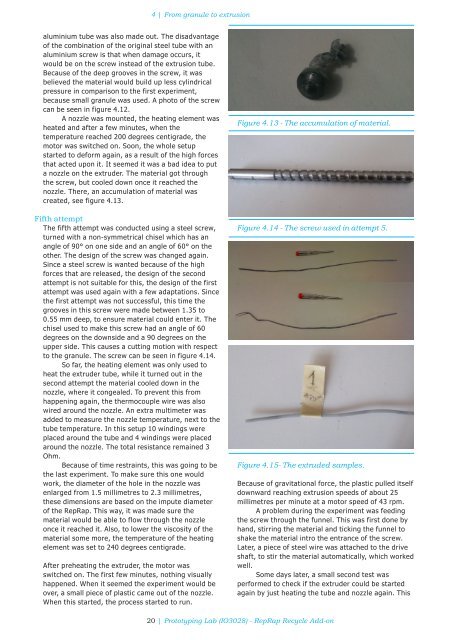reprap-granule-extruder-tudelft1
reprap-granule-extruder-tudelft1
reprap-granule-extruder-tudelft1
Create successful ePaper yourself
Turn your PDF publications into a flip-book with our unique Google optimized e-Paper software.
4 | From <strong>granule</strong> to extrusion<br />
aluminium tube was also made out. The disadvantage<br />
of the combination of the original steel tube with an<br />
aluminium screw is that when damage occurs, it<br />
would be on the screw instead of the extrusion tube.<br />
Because of the deep grooves in the screw, it was<br />
believed the material would build up less cylindrical<br />
pressure in comparison to the first experiment,<br />
because small <strong>granule</strong> was used. A photo of the screw<br />
can be seen in figure 4.12.<br />
A nozzle was mounted, the heating element was<br />
heated and after a few minutes, when the<br />
temperature reached 200 degrees centigrade, the<br />
motor was switched on. Soon, the whole setup<br />
started to deform again, as a result of the high forces<br />
that acted upon it. It seemed it was a bad idea to put<br />
a nozzle on the <strong>extruder</strong>. The material got through<br />
the screw, but cooled down once it reached the<br />
nozzle. There, an accumulation of material was<br />
created, see figure 4.13.<br />
Fifth attempt<br />
The fifth attempt was conducted using a steel screw,<br />
turned with a non-symmetrical chisel which has an<br />
angle of 90° on one side and an angle of 60° on the<br />
other. The design of the screw was changed again.<br />
Since a steel screw is wanted because of the high<br />
forces that are released, the design of the second<br />
attempt is not suitable for this, the design of the first<br />
attempt was used again with a few adaptations. Since<br />
the first attempt was not successful, this time the<br />
grooves in this screw were made between 1.35 to<br />
0.55 mm deep, to ensure material could enter it. The<br />
chisel used to make this screw had an angle of 60<br />
degrees on the downside and a 90 degrees on the<br />
upper side. This causes a cutting motion with respect<br />
to the <strong>granule</strong>. The screw can be seen in figure 4.14.<br />
So far, the heating element was only used to<br />
heat the <strong>extruder</strong> tube, while it turned out in the<br />
second attempt the material cooled down in the<br />
nozzle, where it congealed. To prevent this from<br />
happening again, the thermocouple wire was also<br />
wired around the nozzle. An extra multimeter was<br />
added to measure the nozzle temperature, next to the<br />
tube temperature. In this setup 10 windings were<br />
placed around the tube and 4 windings were placed<br />
around the nozzle. The total resistance remained 3<br />
Ohm.<br />
Because of time restraints, this was going to be<br />
the last experiment. To make sure this one would<br />
work, the diameter of the hole in the nozzle was<br />
enlarged from 1.5 millimetres to 2.3 millimetres,<br />
these dimensions are based on the impute diameter<br />
of the RepRap. This way, it was made sure the<br />
material would be able to flow through the nozzle<br />
once it reached it. Also, to lower the viscosity of the<br />
material some more, the temperature of the heating<br />
element was set to 240 degrees centigrade.<br />
After preheating the <strong>extruder</strong>, the motor was<br />
switched on. The first few minutes, nothing visually<br />
happened. When it seemed the experiment would be<br />
over, a small piece of plastic came out of the nozzle.<br />
When this started, the process started to run.<br />
Figure 4.13 - The accumulation of material.<br />
Figure 4.14 - The screw used in attempt 5.<br />
Figure 4.15- The extruded samples.<br />
Because of gravitational force, the plastic pulled itself<br />
downward reaching extrusion speeds of about 25<br />
millimetres per minute at a motor speed of 43 rpm.<br />
A problem during the experiment was feeding<br />
the screw through the funnel. This was first done by<br />
hand, stirring the material and ticking the funnel to<br />
shake the material intro the entrance of the screw.<br />
Later, a piece of steel wire was attached to the drive<br />
shaft, to stir the material automatically, which worked<br />
well.<br />
Some days later, a small second test was<br />
performed to check if the <strong>extruder</strong> could be started<br />
again by just heating the tube and nozzle again. This<br />
20 | Prototyping Lab (IO3028) - RepRap Recycle Add-on


